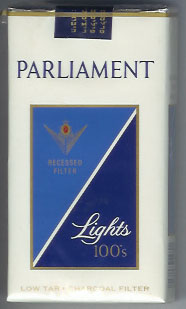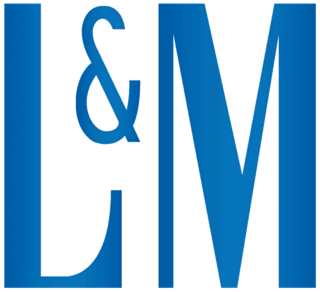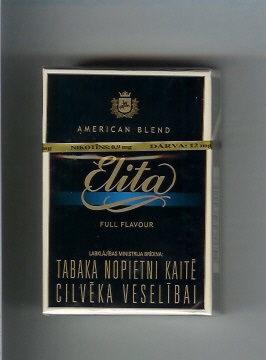
Kool is an American brand of menthol cigarette, currently owned and manufactured by ITG Brands LLC, a subsidiary of Imperial Tobacco Company. Kool cigarettes sold outside of the United States are manufactured by British American Tobacco.

Snus is a tobacco product, originating from a variant of dry snuff in early 18th-century Sweden. It is placed between the upper lip and gum for extended periods, as a form of sublabial administration. Snus is not fermented. Although used similarly to American dipping tobacco, snus does not typically result in the need for spitting and, unlike naswar, snus is steam-pasteurized.

Parliament is an American brand of cigarettes, currently owned and manufactured by Philip Morris USA in the United States and Philip Morris International outside of the United States.
West is a German brand of cigarettes, currently owned and manufactured by Imperial Brands.

Kretek are unfiltered cigarettes of Indonesian origin, made with a blend of tobacco, cloves, and other flavors. The word "kretek" itself is an onomatopoetic term for the crackling sound of burning cloves.
Capri is an American brand of cigarettes. It is currently owned and manufactured by the R. J. Reynolds Tobacco Company.

Silk Cut is a British brand of cigarettes, currently owned and manufactured by Gallaher Group, a division of Japan Tobacco. The packaging is characterised by a distinctive stark white packet with the brand name in a purple, blue, red, silver, white or green square.

L&M is an American brand of cigarettes, currently owned and manufactured by Altria and Philip Morris International. The name comes from the tobacco company founded in 1873 called Liggett & Myers, predecessor of today's Liggett Group, in which L&M was originally produced.
Viceroy is an American brand of cigarettes, currently owned and manufactured by R. J. Reynolds Tobacco Company in the United States and British American Tobacco outside of the United States.
Doral is an American brand of cigarettes, currently owned and manufactured by the R.J. Reynolds Tobacco Company.
Herbal cigarettes are cigarettes that usually do not contain any tobacco or nicotine, instead being composed of a mixture of various herbs and/or other plant material. However, Chinese herbal cigarettes contain tobacco and nicotine with herbs added, unlike European and North American herbal cigarettes which have tobacco and nicotine omitted. Like herbal smokeless tobacco, they are often used as a substitute for standard tobacco products. Herbal cigarettes are often advertised as a smoking cessation aid. They are also used in acting scenes by performers who are non-smokers, or where anti-smoking legislation prohibits the use of tobacco in public spaces. Herbal cigarettes can carry carcinogens.

Next is a brand of cigarettes, currently owned and manufactured by Philip Morris International. The original acronym for Next was a reference to "nicotine extracted".

Merit is an American brand of cigarettes, currently owned and manufactured by Philip Morris USA in the United States and Philip Morris International outside the United States.

f6 is a German cigarette brand owned by Philip Morris International and produced by the f6 Cigarettenfabrik Dresden GmbH.
King's is a Danish brand of cigarettes owned by conglomerate British American Tobacco, and produced by House of Prince.

The tar derby is the period in the 1950s marked by a rapid influx in both cigarette advertising focused on tar content measurements to differentiate cigarettes and brand introduction or repositioning focusing on filter technology. The period ended in 1959 after the Federal Trade Commission (FTC) Chairman and several cigarette company presidents agreed to discontinue usage of tar or nicotine levels in advertisements.

Elita is a Latvian brand of cigarettes that was produced between 1967 and 2009 by the Latvian company "Rīgas Tabakas Fabrika" and later by British American Tobacco. According to the data submitted by the Latvian State Revenue Service, Elita was the most sold brand filtered cigarettes in Latvia for the period of about twenty years.

Peter Stuyvesant is a brand of cigarettes currently owned by British American Tobacco and manufactured by the American Cigarette Company. In Australia and New Zealand, the brand is manufactured by Imperial Tobacco. The cigarette brand is named after Petrus Stuyvesant, Director General of New Netherland, later New York State, New Jersey, Delaware and parts of surrounding states.
Senoussi was a German brand of cigarettes that was owned and manufactured by Reemtsma, a division of Imperial Tobacco. The brand was discontinued in 2002.
Look is a Danish brand of cigarettes, currently owned and manufactured by House of Prince, a subsidiary of British American Tobacco.













